lock YAMAHA YZ125LC 2013 Owners Manual
[x] Cancel search | Manufacturer: YAMAHA, Model Year: 2013, Model line: YZ125LC, Model: YAMAHA YZ125LC 2013Pages: 168, PDF Size: 8.19 MB
Page 8 of 168
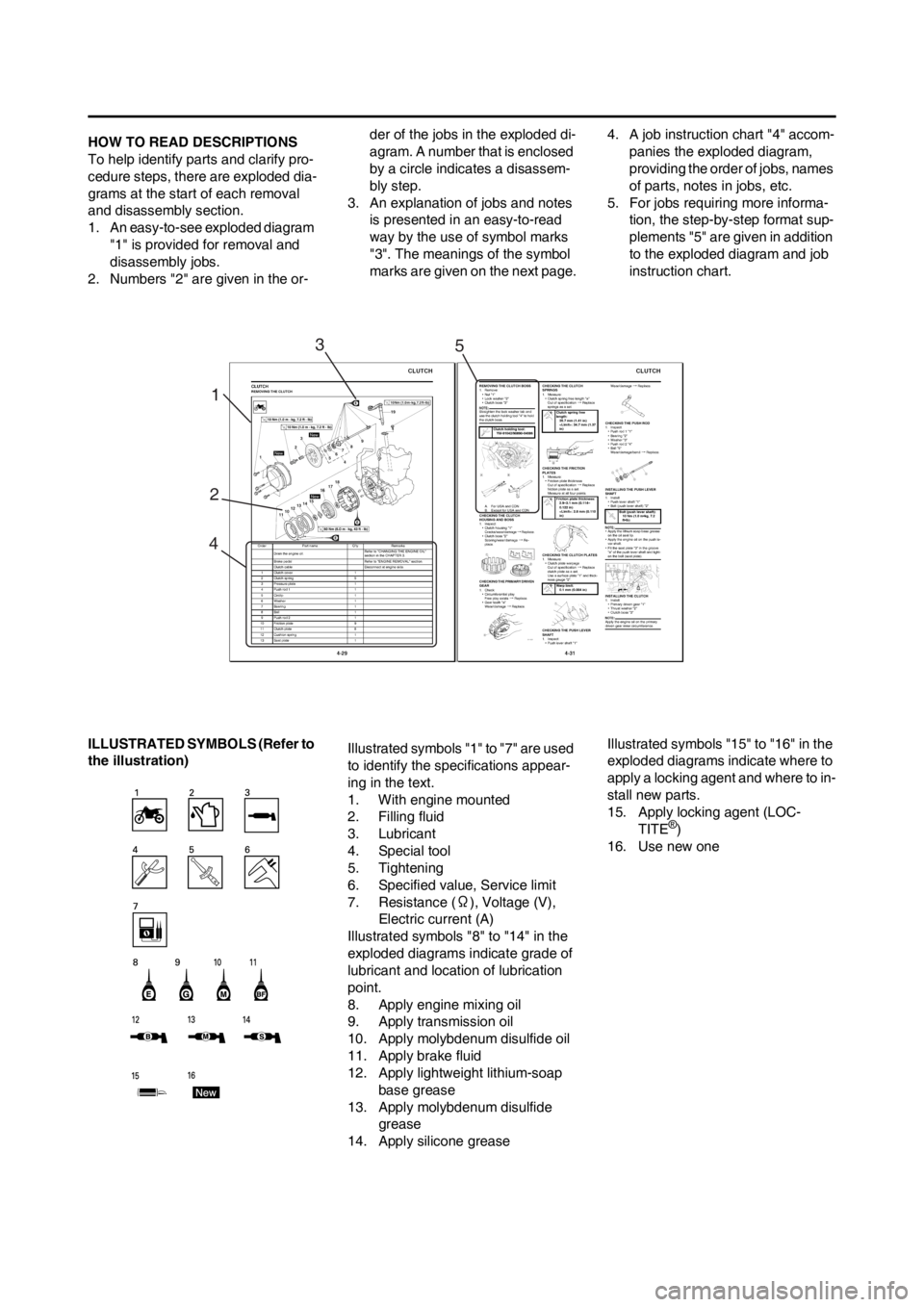
HOW TO READ DESCRIPTIONS
To help identify parts and clarify pro-
cedure steps, there are exploded dia-
grams at the start of each removal
and disassembly section.
1. An easy-to-see exploded diagram
"1" is provided for removal and
disassembly jobs.
2. Numbers "2" are given in the or-der of the jobs in the exploded di-
agram. A number that is enclosed
by a circle indicates a disassem-
bly step.
3. An explanation of jobs and notes
is presented in an easy-to-read
way by the use of symbol marks
"3". The meanings of the symbol
marks are given on the next page.4. A job instruction chart "4" accom-
panies the exploded diagram,
providing the order of jobs, names
of parts, notes in jobs, etc.
5. For jobs requiring more informa-
tion, the step-by-step format sup-
plements "5" are given in addition
to the exploded diagram and job
instruction chart.
ILLUSTRATED SYMBOLS (Refer to
the illustration)Illustrated symbols "1" to "7" are used
to identify the specifications appear-
ing in the text.
1. With engine mounted
2. Filling fluid
3. Lubricant
4. Special tool
5. Tightening
6. Specified value, Service limit
7. Resistance (Ω), Voltage (V),
Electric current (A)
Illustrated symbols "8" to "14" in the
exploded diagrams indicate grade of
lubricant and location of lubrication
point.
8. Apply engine mixing oil
9. Apply transmission oil
10. Apply molybdenum disulfide oil
11. Apply brake fluid
12. Apply lightweight lithium-soap
base grease
13. Apply molybdenum disulfide
grease
14. Apply silicone greaseIllustrated symbols "15" to "16" in the
exploded diagrams indicate where to
apply a locking agent and where to in-
stall new parts.
15. Apply locking agent (LOC-
TITE
®)
16. Use new one
1
23
45
Page 17 of 168
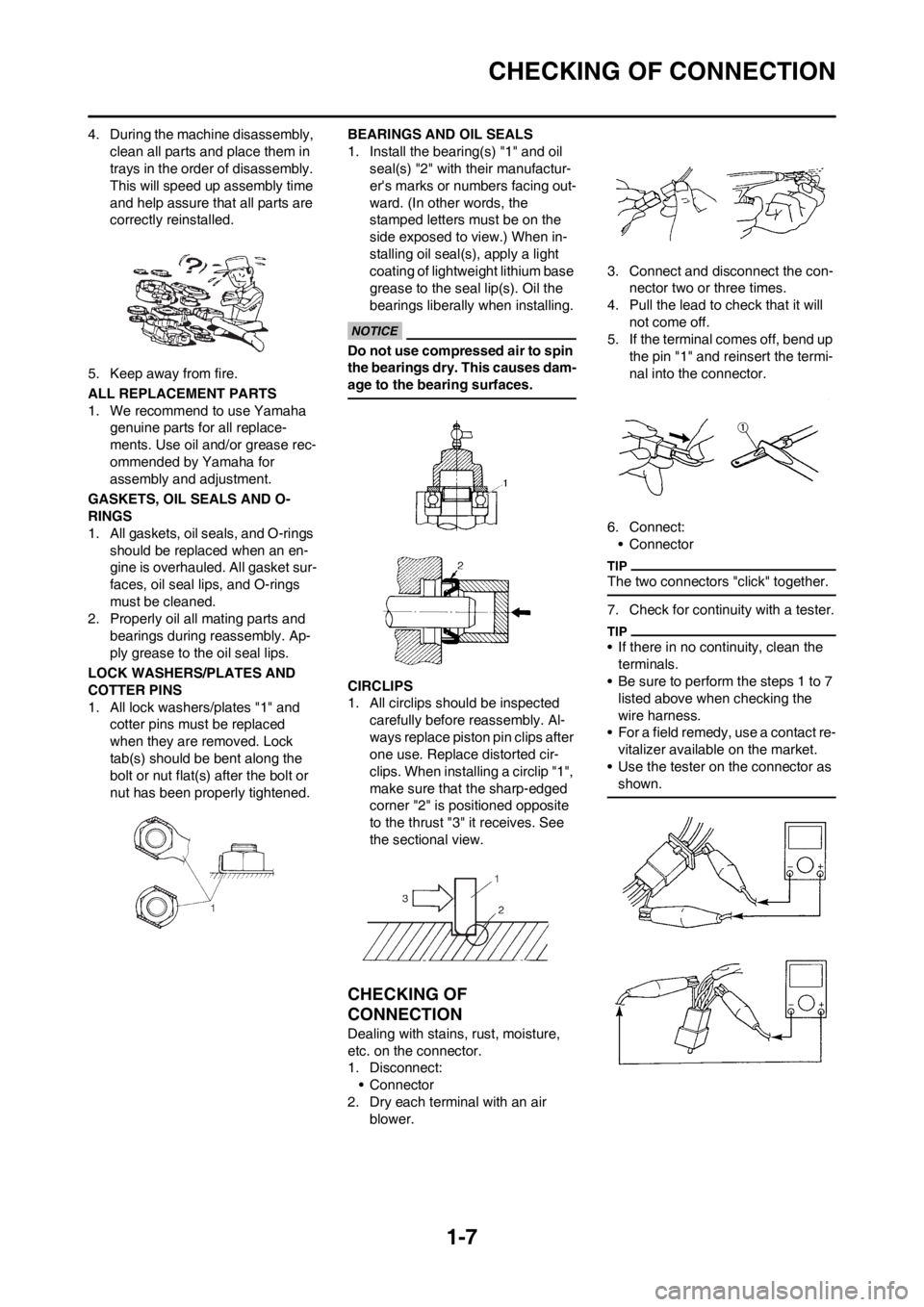
1-7
CHECKING OF CONNECTION
4. During the machine disassembly,
clean all parts and place them in
trays in the order of disassembly.
This will speed up assembly time
and help assure that all parts are
correctly reinstalled.
5. Keep away from fire.
ALL REPLACEMENT PARTS
1. We recommend to use Yamaha
genuine parts for all replace-
ments. Use oil and/or grease rec-
ommended by Yamaha for
assembly and adjustment.
GASKETS, OIL SEALS AND O-
RINGS
1. All gaskets, oil seals, and O-rings
should be replaced when an en-
gine is overhauled. All gasket sur-
faces, oil seal lips, and O-rings
must be cleaned.
2. Properly oil all mating parts and
bearings during reassembly. Ap-
ply grease to the oil seal lips.
LOCK WASHERS/PLATES AND
COTTER PINS
1. All lock washers/plates "1" and
cotter pins must be replaced
when they are removed. Lock
tab(s) should be bent along the
bolt or nut flat(s) after the bolt or
nut has been properly tightened.BEARINGS AND OIL SEALS
1. Install the bearing(s) "1" and oil
seal(s) "2" with their manufactur-
er's marks or numbers facing out-
ward. (In other words, the
stamped letters must be on the
side exposed to view.) When in-
stalling oil seal(s), apply a light
coating of lightweight lithium base
grease to the seal lip(s). Oil the
bearings liberally when installing.
Do not use compressed air to spin
the bearings dry. This causes dam-
age to the bearing surfaces.
CIRCLIPS
1. All circlips should be inspected
carefully before reassembly. Al-
ways replace piston pin clips after
one use. Replace distorted cir-
clips. When installing a circlip "1",
make sure that the sharp-edged
corner "2" is positioned opposite
to the thrust "3" it receives. See
the sectional view.
CHECKING OF
CONNECTION
Dealing with stains, rust, moisture,
etc. on the connector.
1. Disconnect:
• Connector
2. Dry each terminal with an air
blower.3. Connect and disconnect the con-
nector two or three times.
4. Pull the lead to check that it will
not come off.
5. If the terminal comes off, bend up
the pin "1" and reinsert the termi-
nal into the connector.
6. Connect:
• Connector
The two connectors "click" together.
7. Check for continuity with a tester.
• If there in no continuity, clean the
terminals.
• Be sure to perform the steps 1 to 7
listed above when checking the
wire harness.
• For a field remedy, use a contact re-
vitalizer available on the market.
• Use the tester on the connector as
shown.
Page 24 of 168
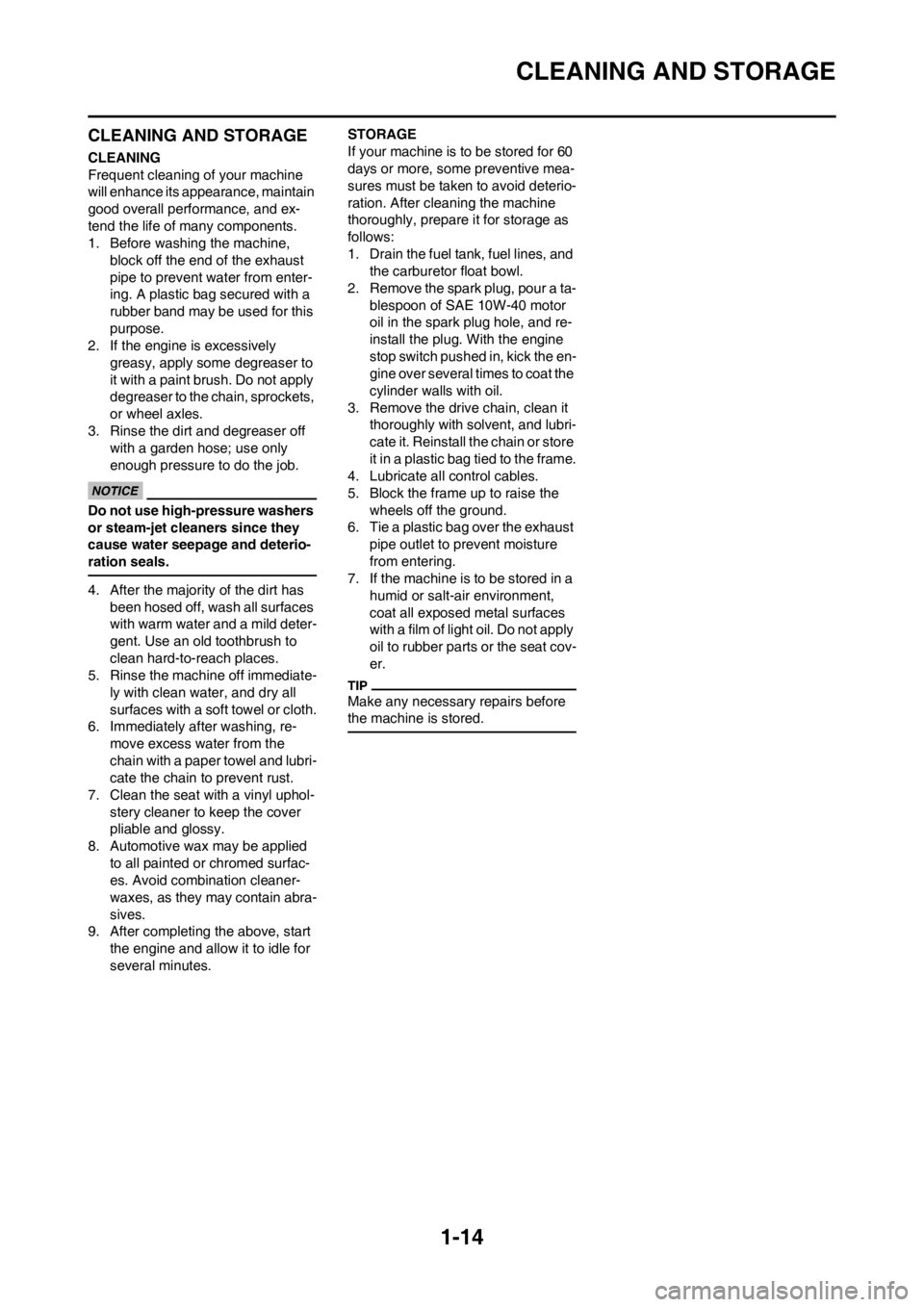
1-14
CLEANING AND STORAGE
CLEANING AND STORAGE
CLEANING
Frequent cleaning of your machine
will enhance its appearance, maintain
good overall performance, and ex-
tend the life of many components.
1. Before washing the machine,
block off the end of the exhaust
pipe to prevent water from enter-
ing. A plastic bag secured with a
rubber band may be used for this
purpose.
2. If the engine is excessively
greasy, apply some degreaser to
it with a paint brush. Do not apply
degreaser to the chain, sprockets,
or wheel axles.
3. Rinse the dirt and degreaser off
with a garden hose; use only
enough pressure to do the job.
Do not use high-pressure washers
or steam-jet cleaners since they
cause water seepage and deterio-
ration seals.
4. After the majority of the dirt has
been hosed off, wash all surfaces
with warm water and a mild deter-
gent. Use an old toothbrush to
clean hard-to-reach places.
5. Rinse the machine off immediate-
ly with clean water, and dry all
surfaces with a soft towel or cloth.
6. Immediately after washing, re-
move excess water from the
chain with a paper towel and lubri-
cate the chain to prevent rust.
7. Clean the seat with a vinyl uphol-
stery cleaner to keep the cover
pliable and glossy.
8. Automotive wax may be applied
to all painted or chromed surfac-
es. Avoid combination cleaner-
waxes, as they may contain abra-
sives.
9. After completing the above, start
the engine and allow it to idle for
several minutes.STORAGE
If your machine is to be stored for 60
days or more, some preventive mea-
sures must be taken to avoid deterio-
ration. After cleaning the machine
thoroughly, prepare it for storage as
follows:
1. Drain the fuel tank, fuel lines, and
the carburetor float bowl.
2. Remove the spark plug, pour a ta-
blespoon of SAE 10W-40 motor
oil in the spark plug hole, and re-
install the plug. With the engine
stop switch pushed in, kick the en-
gine over several times to coat the
cylinder walls with oil.
3. Remove the drive chain, clean it
thoroughly with solvent, and lubri-
cate it. Reinstall the chain or store
it in a plastic bag tied to the frame.
4. Lubricate all control cables.
5. Block the frame up to raise the
wheels off the ground.
6. Tie a plastic bag over the exhaust
pipe outlet to prevent moisture
from entering.
7. If the machine is to be stored in a
humid or salt-air environment,
coat all exposed metal surfaces
with a film of light oil. Do not apply
oil to rubber parts or the seat cov-
er.
Make any necessary repairs before
the machine is stored.
Page 32 of 168

2-8
TIGHTENING TORQUES
Radiator hose clamp M6 8 2 Nm (0.2 m•kg, 1.4 ft•lb)
Air filter element M6 1 2 Nm (0.2 m•kg, 1.4 ft•lb)
Carburetor joint M6 4 10 Nm (1.0 m•kg, 7.2 ft•lb)
Carburetor joint clamp M4 1 2 Nm (0.2 m•kg, 1.4 ft•lb)
Air filter joint clamp M4 1 2 Nm (0.2 m•kg, 1.4 ft•lb)
△Air filter case M6 4 8 Nm (0.8 m•kg, 5.8 ft•lb)
Air filter guide clamp M5 1 4 Nm (0.4 m•kg, 2.9 ft•lb)
Reed valve M3 6 1 Nm (0.1 m•kg, 0.7 ft•lb)
Throttle cable adjust bolt and locknut M8 1 7 Nm (0.7 m•kg, 5.1 ft•lb)
Throttle cable M6 1 4 Nm (0.4 m•kg, 2.9 ft•lb)
Crankcase M6 12 14 Nm (1.4 m•kg, 10 ft•lb)
Right crankcase cover M6 8 10 Nm (1.0 m•kg, 7.2 ft•lb)
Left crankcase cover M6 4 5 Nm (0.5 m•kg, 3.6 ft•lb)
Drive chain sprocket cover M6 2 5 Nm (0.5 m•kg, 3.6 ft•lb)
Bearing plate cover M6 4 10 Nm (1.0 m•kg, 7.2 ft•lb)
Holder M6 1 10 Nm (1.0 m•kg, 7.2 ft•lb)
Oil check bolt M6 1 10 Nm (1.0 m•kg, 7.2 ft•lb)Copper
washer
Oil drain bolt M10 1 20 Nm (2.0 m•kg, 14 ft•lb)Copper
washer
Kickstarter crank M6 1 10 Nm (1.0 m•kg, 7.2 ft•lb)
Clutch cover M6 6 10 Nm (1.0 m•kg, 7.2 ft•lb)
Primary drive gear M8 1 48 Nm (4.8 m•kg, 35 ft•lb)
Clutch boss M16 1 80 Nm (8.0 m•kg, 58 ft•lb) Lock washer
Clutch spring M6 5 10 Nm (1.0 m•kg, 7.2 ft•lb)
Clutch cable adjust bolt and locknutM6 1 4 Nm (0.4 m•kg, 2.9 ft•lb)
Drive sprocket M18 1 75 Nm (7.5 m•kg, 54 ft•lb) Lock washer
Shift pedal M6 1 12 Nm (1.2 m•kg, 8.7 ft•lb)
Bearing plate cover (shift cam) M6 2 10 Nm (1.0 m•kg, 7.2 ft•lb)
Shift guide M6 2 10 Nm (1.0 m•kg, 7.2 ft•lb)
Stopper lever M6 1 10 Nm (1.0 m•kg, 7.2 ft•lb)
Segment M8 1 30 Nm (3.0 m•kg, 22 ft•lb)
△Exhaust pipe M6 2 12 Nm (1.2 m•kg, 8.7 ft•lb)
△Exhaust pipe stay (front) M6 1 12 Nm (1.2 m•kg, 8.7 ft•lb)
△Exhaust pipe stay (rear) M6 1 12 Nm (1.2 m•kg, 8.7 ft•lb)
Silencer:
△Silencer and frame M6 2 12 Nm (1.2 m•kg, 8.7 ft•lb)
Fiber M6 4 10 Nm (1.0 m•kg, 7.2 ft•lb)ItemThread
sizeQ'ty Tightening torque Remarks
Page 33 of 168
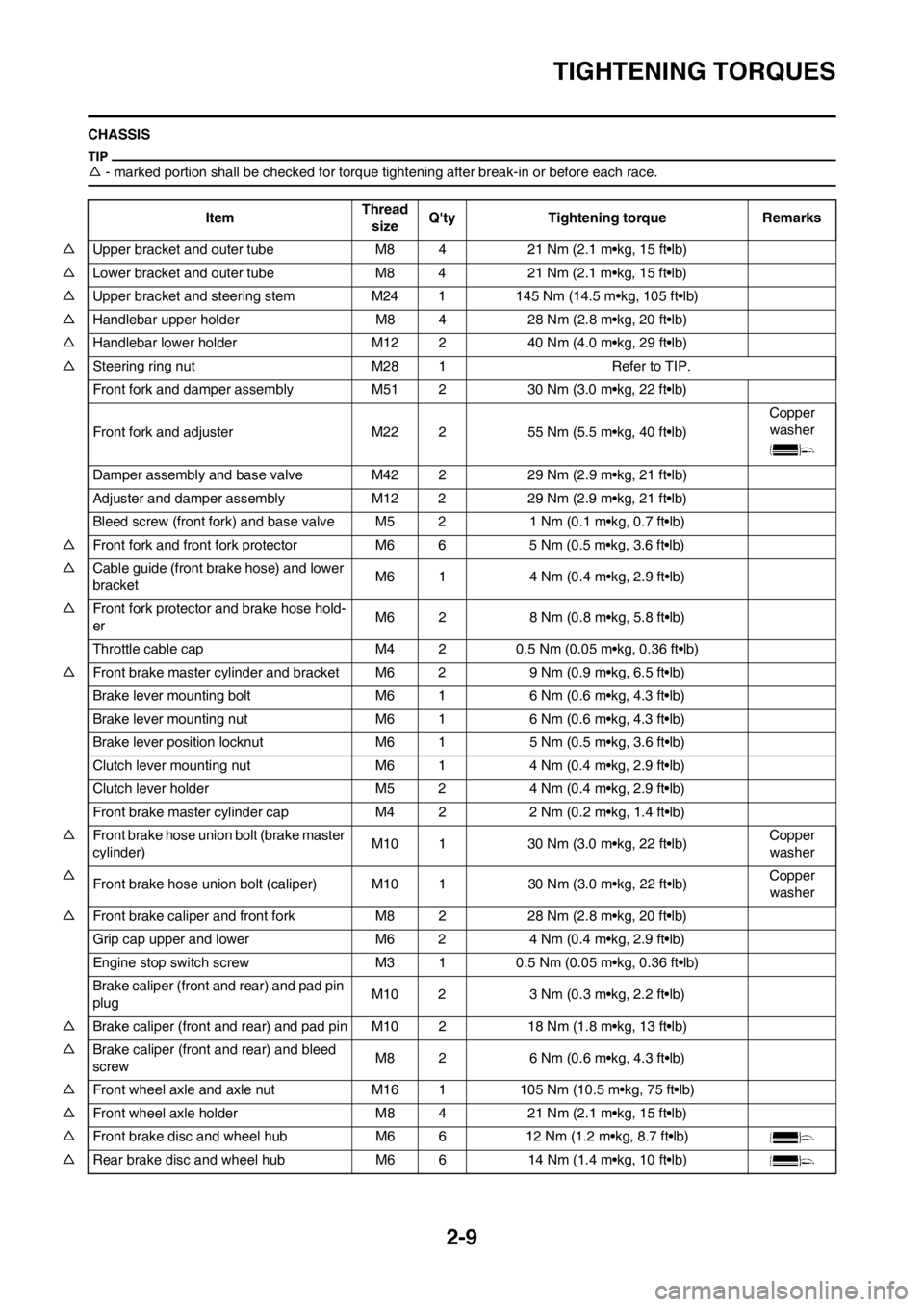
2-9
TIGHTENING TORQUES
CHASSIS
△- marked portion shall be checked for torque tightening after break-in or before each race.
ItemThread
sizeQ'ty Tightening torque Remarks
△Upper bracket and outer tube M84 21 Nm (2.1 m•kg, 15 ft•lb)
△Lower bracket and outer tube M8 4 21 Nm (2.1 m•kg, 15 ft•lb)
△Upper bracket and steering stem M24 1 145 Nm (14.5 m•kg, 105 ft•lb)
△Handlebar upper holder M8 4 28 Nm (2.8 m•kg, 20 ft•lb)
△Handlebar lower holder M12 2 40 Nm (4.0 m•kg, 29 ft•lb)
△Steering ring nut M28 1 Refer to TIP.
Front fork and damper assembly M51 2 30 Nm (3.0 m•kg, 22 ft•lb)
Front fork and adjuster M22 2 55 Nm (5.5 m•kg, 40 ft•lb)Copper
washer
Damper assembly and base valve M42 2 29 Nm (2.9 m•kg, 21 ft•lb)
Adjuster and damper assembly M12 2 29 Nm (2.9 m•kg, 21 ft•lb)
Bleed screw (front fork) and base valve M5 2 1 Nm (0.1 m•kg, 0.7 ft•lb)
△Front fork and front fork protector M6 6 5 Nm (0.5 m•kg, 3.6 ft•lb)
△Cable guide (front brake hose) and lower
bracketM6 1 4 Nm (0.4 m•kg, 2.9 ft•lb)
△Front fork protector and brake hose hold-
erM6 2 8 Nm (0.8 m•kg, 5.8 ft•lb)
Throttle cable cap M4 2 0.5 Nm (0.05 m•kg, 0.36 ft•lb)
△Front brake master cylinder and bracket M6 2 9 Nm (0.9 m•kg, 6.5 ft•lb)
Brake lever mounting bolt M6 1 6 Nm (0.6 m•kg, 4.3 ft•lb)
Brake lever mounting nut M6 1 6 Nm (0.6 m•kg, 4.3 ft•lb)
Brake lever position locknut M6 1 5 Nm (0.5 m•kg, 3.6 ft•lb)
Clutch lever mounting nut M6 1 4 Nm (0.4 m•kg, 2.9 ft•lb)
Clutch lever holder M5 2 4 Nm (0.4 m•kg, 2.9 ft•lb)
Front brake master cylinder cap M4 2 2 Nm (0.2 m•kg, 1.4 ft•lb)
△Front brake hose union bolt (brake master
cylinder)M10 1 30 Nm (3.0 m•kg, 22 ft•lb)Copper
washer
△
Front brake hose union bolt (caliper) M10 1 30 Nm (3.0 m•kg, 22 ft•lb)Copper
washer
△Front brake caliper and front fork M8 2 28 Nm (2.8 m•kg, 20 ft•lb)
Grip cap upper and lower M6 2 4 Nm (0.4 m•kg, 2.9 ft•lb)
Engine stop switch screw M3 1 0.5 Nm (0.05 m•kg, 0.36 ft•lb)
Brake caliper (front and rear) and pad pin
plugM10 2 3 Nm (0.3 m•kg, 2.2 ft•lb)
△Brake caliper (front and rear) and pad pin M10 2 18 Nm (1.8 m•kg, 13 ft•lb)
△Brake caliper (front and rear) and bleed
screwM8 2 6 Nm (0.6 m•kg, 4.3 ft•lb)
△Front wheel axle and axle nut M16 1 105 Nm (10.5 m•kg, 75 ft•lb)
△Front wheel axle holder M8 4 21 Nm (2.1 m•kg, 15 ft•lb)
△Front brake disc and wheel hub M6 6 12 Nm (1.2 m•kg, 8.7 ft•lb)
△Rear brake disc and wheel hub M6 6 14 Nm (1.4 m•kg, 10 ft•lb)
Page 34 of 168

2-10
TIGHTENING TORQUES
Footrest bracket and frame M10 4 55 Nm (5.5 m•kg, 40 ft•lb)T O R X
△Brake pedal mounting M8 1 26 Nm (2.6 m•kg, 19 ft•lb)
△Rear brake master cylinder and frame M6 2 10 Nm (1.0 m•kg, 7.2 ft•lb)
Rear brake master cylinder cap M4 2 2 Nm (0.2 m•kg, 1.4 ft•lb)
△
Rear brake hose union bolt (caliper) M10 1 30 Nm (3.0 m•kg, 22 ft•lb)Copper
washer
△Rear brake hose union bolt (master cylin-
der)M10 1 30 Nm (3.0 m•kg, 22 ft•lb)Copper
washer
△Rear wheel axle and axle nut M20 1 125 Nm (12.5 m•kg, 90 ft•lb)
△Nipple (spoke) — 72 3 Nm (0.3 m•kg, 2.2 ft•lb)
△Driven sprocket and wheel hub M8 6 42 Nm (4.2 m•kg, 30 ft•lb)
△Disc cover and rear brake caliper M6 2 10 Nm (1.0 m•kg, 7.2 ft•lb)
△Protector and rear brake caliper M6 2 7 Nm (0.7 m•kg, 5.1 ft•lb)
Drive chain puller adjust bolt and locknut M8 2 19 Nm (1.9 m•kg, 13 ft•lb)
Engine:
△Engine and frame (front) M10 1 64 Nm (6.4 m•kg, 46 ft•lb)
△Engine and frame (lower) M10 1 64 Nm (6.4 m•kg, 46 ft•lb)
△Engine bracket and frame M8 2 34 Nm (3.4 m•kg, 24 ft•lb)
△Engine bracket and engine M8 1 34 Nm (3.4 m•kg, 24 ft•lb)
△Pivot shaft and nut M16 1 85 Nm (8.5 m•kg, 61 ft•lb)
△Relay arm and swingarm M14 1 70 Nm (7.0 m•kg, 50 ft•lb)
△Relay arm and connecting rod M14 1 80 Nm (8.0 m•kg, 58 ft•lb)
△Connecting rod and frame M14 1 80 Nm (8.0 m•kg, 58 ft•lb)
△Rear shock absorber and frame M10 1 56 Nm (5.6 m•kg, 40 ft•lb)
△Rear shock absorber and relay arm M10 1 53 Nm (5.3 m•kg, 38 ft•lb)
Rear shock absorber adjust locknut M56 1 30 Nm (3.0 m•kg, 22 ft•lb)
△Rear frame and frame (upper) M8 1 32 Nm (3.2 m•kg, 23 ft•lb)
△Rear frame and frame (lower) M8 2 29 Nm (2.9 m•kg, 21 ft•lb)
△Swingarm and brake hose holder M54 3 Nm (0.3 m•kg, 2.2 ft•lb)
Swingarm and patch M4 4 2 Nm (0.2 m•kg, 1.4 ft•lb)
Drive chain tensioner M8 2 16 Nm (1.6 m•kg, 11 ft•lb)
Drive chain support and swingarm M6 37 Nm (0.7 m•kg, 5.1 ft•lb)
Seal guard and swingarm M5 4 6 Nm (0.6 m•kg, 4.3 ft•lb)
Cable guide and frame M5 2 4 Nm (0.4 m•kg, 2.9 ft•lb)
△Fuel tank boss and frame M10 2 20 Nm (2.0 m•kg, 14 ft•lb)
△Fuel tank M6 2 10 Nm (1.0 m•kg, 7.2 ft•lb)
△Fuel tank and fuel cock M6 2 4 Nm (0.4 m•kg, 2.9 ft•lb)
Fuel tank and seat set bracket M6 1 7 Nm (0.7 m•kg, 5.1 ft•lb)
Fuel tank and hooking screw (fitting band) M6 1 7 Nm (0.7 m•kg, 5.1 ft•lb)
Fuel tank and fuel tank bracket M6 4 7 Nm (0.7 m•kg, 5.1 ft•lb)
△Air scoop and fuel tank M6 4 7 Nm (0.7 m•kg, 5.1 ft•lb)
△Air scoop and radiator guard (lower) M6 2 6 Nm (0.6 m•kg, 4.3 ft•lb)
△Front fender M6 4 7 Nm (0.7 m•kg, 5.1 ft•lb)ItemThread
sizeQ'ty Tightening torque Remarks
Page 40 of 168
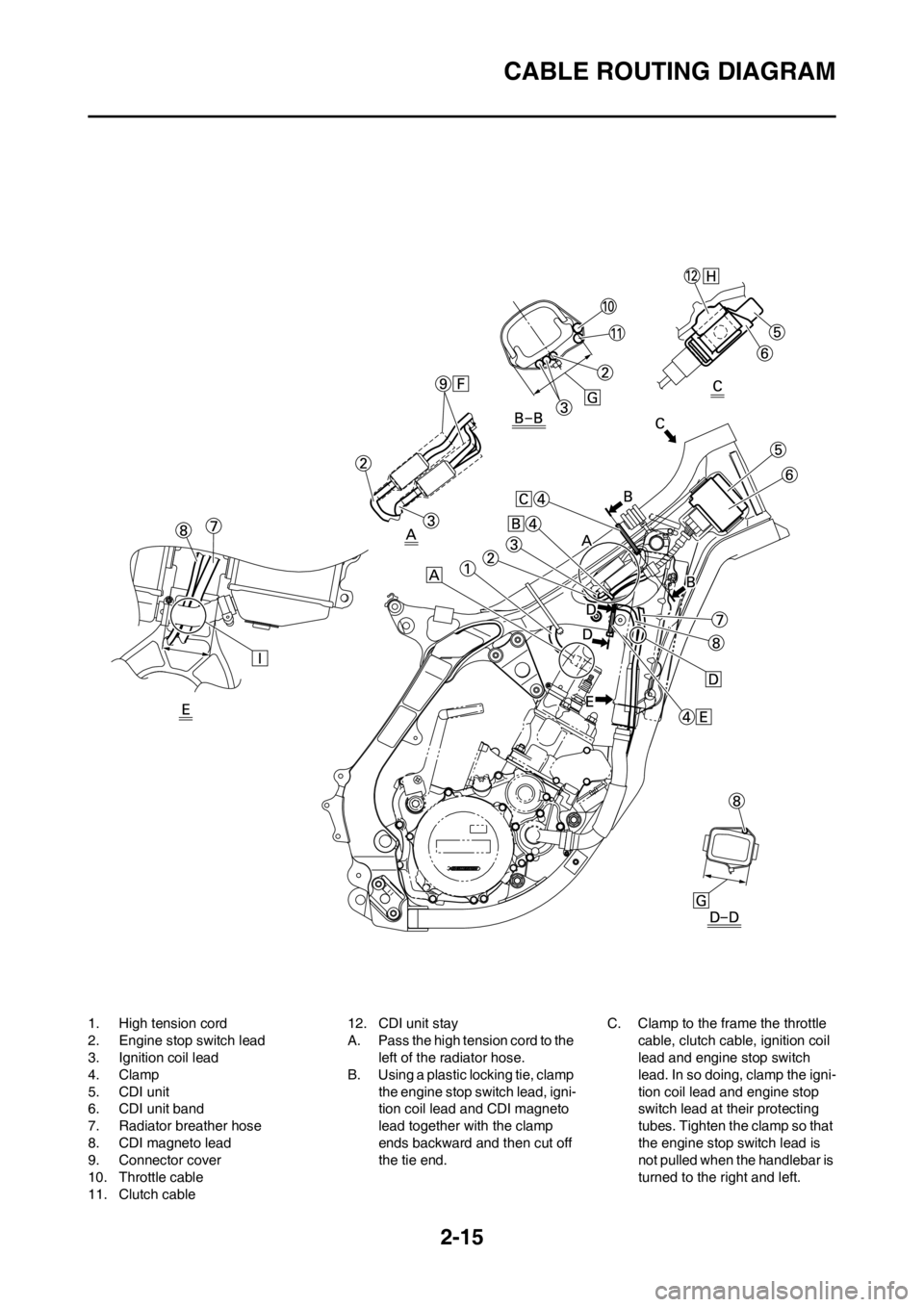
2-15
CABLE ROUTING DIAGRAM
1. High tension cord
2. Engine stop switch lead
3. Ignition coil lead
4. Clamp
5. CDI unit
6. CDI unit band
7. Radiator breather hose
8. CDI magneto lead
9. Connector cover
10. Throttle cable
11. Clutch cable12. CDI unit stay
A. Pass the high tension cord to the
left of the radiator hose.
B. Using a plastic locking tie, clamp
the engine stop switch lead, igni-
tion coil lead and CDI magneto
lead together with the clamp
ends backward and then cut off
the tie end.C. Clamp to the frame the throttle
cable, clutch cable, ignition coil
lead and engine stop switch
lead. In so doing, clamp the igni-
tion coil lead and engine stop
switch lead at their protecting
tubes. Tighten the clamp so that
the engine stop switch lead is
not pulled when the handlebar is
turned to the right and left.
Page 49 of 168
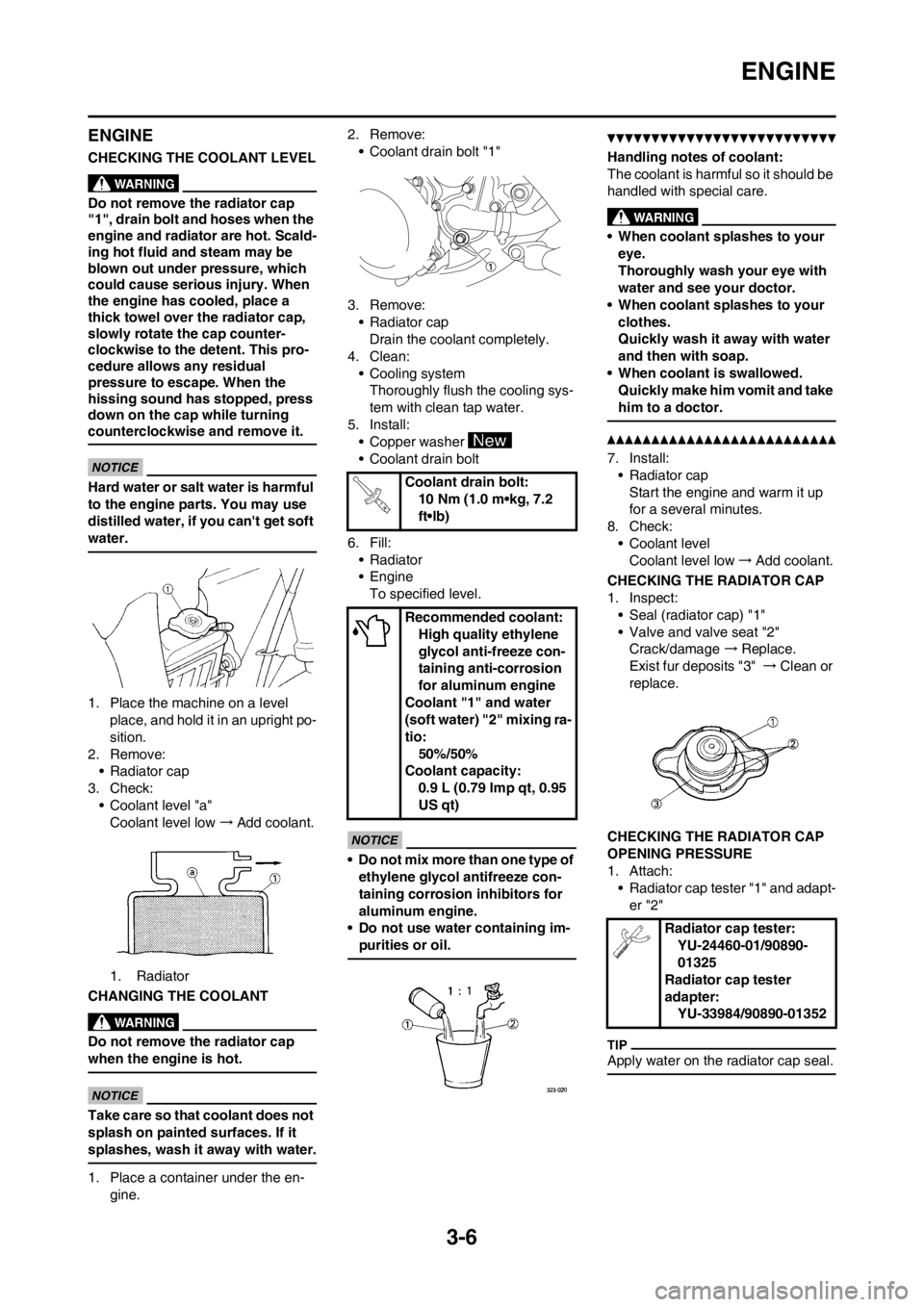
3-6
ENGINE
ENGINE
CHECKING THE COOLANT LEVEL
Do not remove the radiator cap
"1", drain bolt and hoses when the
engine and radiator are hot. Scald-
ing hot fluid and steam may be
blown out under pressure, which
could cause serious injury. When
the engine has cooled, place a
thick towel over the radiator cap,
slowly rotate the cap counter-
clockwise to the detent. This pro-
cedure allows any residual
pressure to escape. When the
hissing sound has stopped, press
down on the cap while turning
counterclockwise and remove it.
Hard water or salt water is harmful
to the engine parts. You may use
distilled water, if you can't get soft
water.
1. Place the machine on a level
place, and hold it in an upright po-
sition.
2. Remove:
• Radiator cap
3. Check:
• Coolant level "a"
Coolant level low →Add coolant.
1. Radiator
CHANGING THE COOLANT
Do not remove the radiator cap
when the engine is hot.
Take care so that coolant does not
splash on painted surfaces. If it
splashes, wash it away with water.
1. Place a container under the en-
gine.2. Remove:
• Coolant drain bolt "1"
3. Remove:
• Radiator cap
Drain the coolant completely.
4. Clean:
• Cooling system
Thoroughly flush the cooling sys-
tem with clean tap water.
5. Install:
• Copper washer
• Coolant drain bolt
6. Fill:
• Radiator
•Engine
To specified level.
• Do not mix more than one type of
ethylene glycol antifreeze con-
taining corrosion inhibitors for
aluminum engine.
• Do not use water containing im-
purities or oil.
Handling notes of coolant:
The coolant is harmful so it should be
handled with special care.
• When coolant splashes to your
eye.
Thoroughly wash your eye with
water and see your doctor.
• When coolant splashes to your
clothes.
Quickly wash it away with water
and then with soap.
• When coolant is swallowed.
Quickly make him vomit and take
him to a doctor.
7. Install:
• Radiator cap
Start the engine and warm it up
for a several minutes.
8. Check:
• Coolant level
Coolant level low→Add coolant.
CHECKING THE RADIATOR CAP
1. Inspect:
• Seal (radiator cap) "1"
• Valve and valve seat "2"
Crack/damage →Replace.
Exist fur deposits "3" →Clean or
replace.
CHECKING THE RADIATOR CAP
OPENING PRESSURE
1. Attach:
• Radiator cap tester "1" and adapt-
er "2"
Apply water on the radiator cap seal.
Coolant drain bolt:
10 Nm (1.0 m•kg, 7.2
ft•lb)
Recommended coolant:
High quality ethylene
glycol anti-freeze con-
taining anti-corrosion
for aluminum engine
Coolant "1" and water
(soft water) "2" mixing ra-
tio:
50%/50%
Coolant capacity:
0.9 L (0.79 Imp qt, 0.95
US qt)
Radiator cap tester:
YU-24460-01/90890-
01325
Radiator cap tester
adapter:
YU-33984/90890-01352
Page 50 of 168
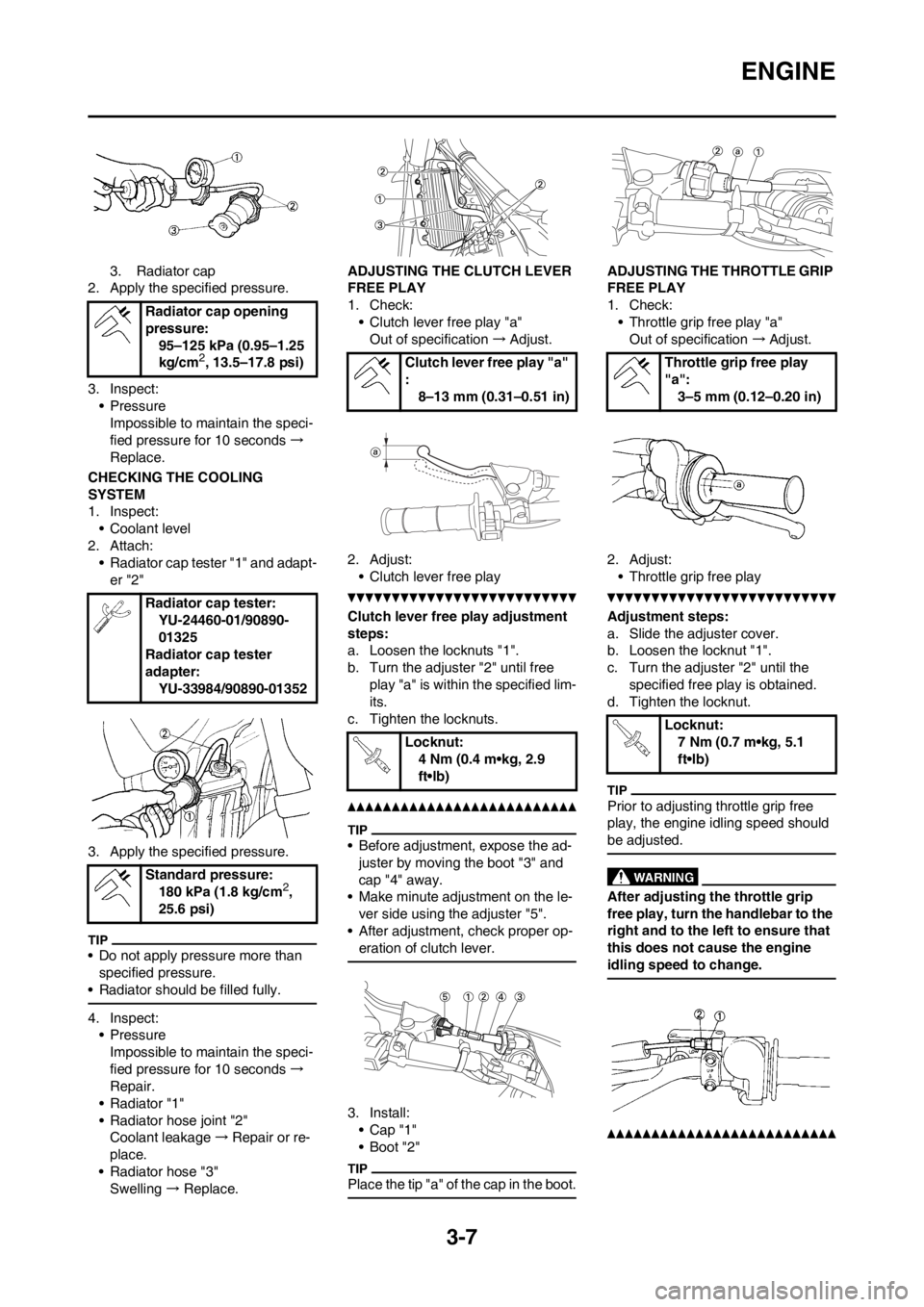
3-7
ENGINE
3. Radiator cap
2. Apply the specified pressure.
3. Inspect:
• Pressure
Impossible to maintain the speci-
fied pressure for 10 seconds →
Replace.
CHECKING THE COOLING
SYSTEM
1. Inspect:
• Coolant level
2. Attach:
• Radiator cap tester "1" and adapt-
er "2"
3. Apply the specified pressure.
• Do not apply pressure more than
specified pressure.
• Radiator should be filled fully.
4. Inspect:
• Pressure
Impossible to maintain the speci-
fied pressure for 10 seconds →
Repair.
•Radiator "1"
• Radiator hose joint "2"
Coolant leakage →Repair or re-
place.
• Radiator hose "3"
Swelling → Replace. ADJUSTING THE CLUTCH LEVER
FREE PLAY
1. Check:
• Clutch lever free play "a"
Out of specification →Adjust.
2. Adjust:
• Clutch lever free play
Clutch lever free play adjustment
steps:
a. Loosen the locknuts "1".
b. Turn the adjuster "2" until free
play "a" is within the specified lim-
its.
c. Tighten the locknuts.
• Before adjustment, expose the ad-
juster by moving the boot "3" and
cap "4" away.
• Make minute adjustment on the le-
ver side using the adjuster "5".
• After adjustment, check proper op-
eration of clutch lever.
3. Install:
• Cap "1"
•Boot "2"
Place the tip "a" of the cap in the boot.
ADJUSTING THE THROTTLE GRIP
FREE PLAY
1. Check:
• Throttle grip free play "a"
Out of specification →Adjust.
2. Adjust:
• Throttle grip free play
Adjustment steps:
a. Slide the adjuster cover.
b. Loosen the locknut "1".
c. Turn the adjuster "2" until the
specified free play is obtained.
d. Tighten the locknut.
Prior to adjusting throttle grip free
play, the engine idling speed should
be adjusted.
After adjusting the throttle grip
free play, turn the handlebar to the
right and to the left to ensure that
this does not cause the engine
idling speed to change.
Radiator cap opening
pressure:
95–125 kPa (0.95–1.25
kg/cm
2, 13.5–17.8 psi)
Radiator cap tester:
YU-24460-01/90890-
01325
Radiator cap tester
adapter:
YU-33984/90890-01352
Standard pressure:
180 kPa (1.8 kg/cm
2,
25.6 psi)
Clutch lever free play "a"
:
8–13 mm (0.31–0.51 in)
Locknut:
4 Nm (0.4 m•kg, 2.9
ft•lb)Throttle grip free play
"a":
3–5 mm (0.12–0.20 in)
Locknut:
7 Nm (0.7 m•kg, 5.1
ft•lb)
Page 52 of 168
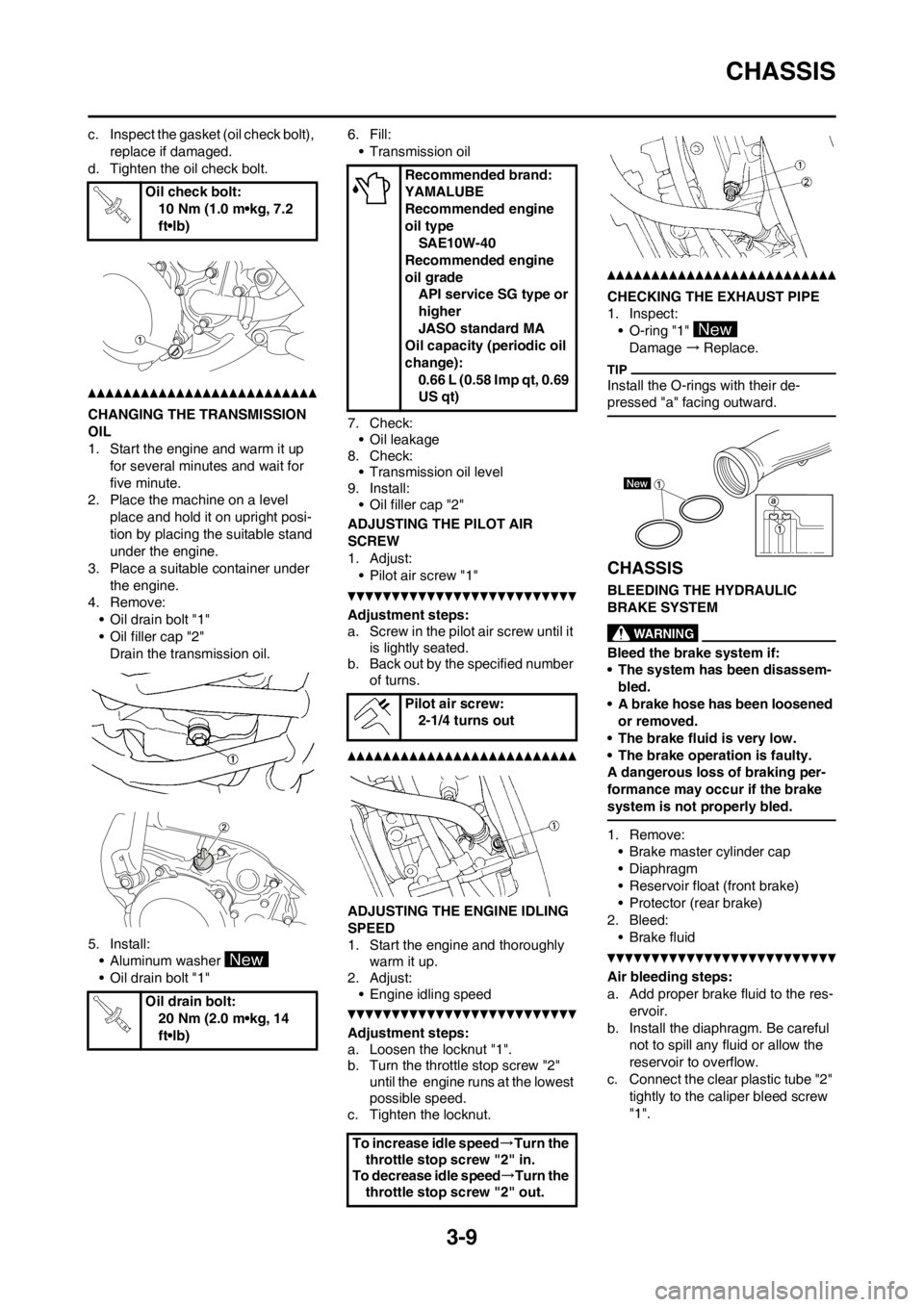
3-9
CHASSIS
c. Inspect the gasket (oil check bolt),
replace if damaged.
d. Tighten the oil check bolt.
CHANGING THE TRANSMISSION
OIL
1. Start the engine and warm it up
for several minutes and wait for
five minute.
2. Place the machine on a level
place and hold it on upright posi-
tion by placing the suitable stand
under the engine.
3. Place a suitable container under
the engine.
4. Remove:
• Oil drain bolt "1"
• Oil filler cap "2"
Drain the transmission oil.
5. Install:
• Aluminum washer
• Oil drain bolt "1"6. Fill:
• Transmission oil
7. Check:
• Oil leakage
8. Check:
• Transmission oil level
9. Install:
• Oil filler cap "2"
ADJUSTING THE PILOT AIR
SCREW
1. Adjust:
• Pilot air screw "1"
Adjustment steps:
a. Screw in the pilot air screw until it
is lightly seated.
b. Back out by the specified number
of turns.
ADJUSTING THE ENGINE IDLING
SPEED
1. Start the engine and thoroughly
warm it up.
2. Adjust:
• Engine idling speed
Adjustment steps:
a. Loosen the locknut "1".
b. Turn the throttle stop screw "2"
until the engine runs at the lowest
possible speed.
c. Tighten the locknut.
CHECKING THE EXHAUST PIPE
1. Inspect:
• O-ring "1"
Damage →Replace.
Install the O-rings with their de-
pressed "a" facing outward.
CHASSIS
BLEEDING THE HYDRAULIC
BRAKE SYSTEM
Bleed the brake system if:
• The system has been disassem-
bled.
• A brake hose has been loosened
or removed.
• The brake fluid is very low.
• The brake operation is faulty.
A dangerous loss of braking per-
formance may occur if the brake
system is not properly bled.
1. Remove:
• Brake master cylinder cap
• Diaphragm
• Reservoir float (front brake)
• Protector (rear brake)
2. Bleed:
• Brake fluid
Air bleeding steps:
a. Add proper brake fluid to the res-
ervoir.
b. Install the diaphragm. Be careful
not to spill any fluid or allow the
reservoir to overflow.
c. Connect the clear plastic tube "2"
tightly to the caliper bleed screw
"1". Oil check bolt:
10 Nm (1.0 m•kg, 7.2
ft•lb)
Oil drain bolt:
20 Nm (2.0 m•kg, 14
ft•lb)
Recommended brand:
YAMALUBE
Recommended engine
oil type
SAE10W-40
Recommended engine
oil grade
API service SG type or
higher
JASO standard MA
Oil capacity (periodic oil
change):
0.66 L (0.58 Imp qt, 0.69
US qt)
Pilot air screw:
2-1/4 turns out
To increase idle speed→Turn the
throttle stop screw "2" in.
To decrease idle speed→Turn the
throttle stop screw "2" out.